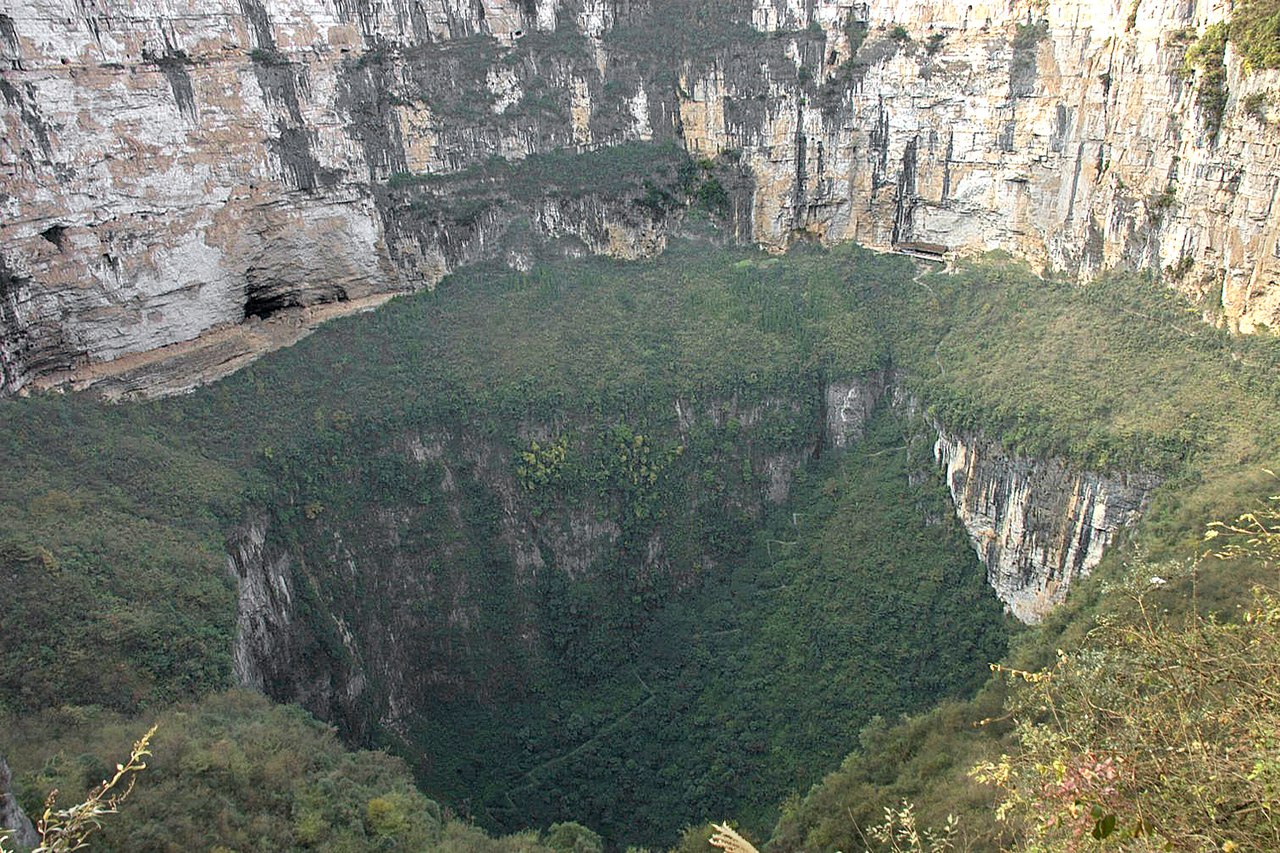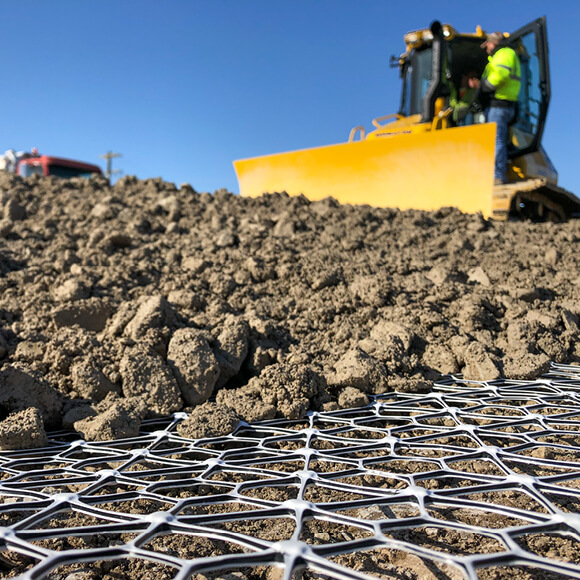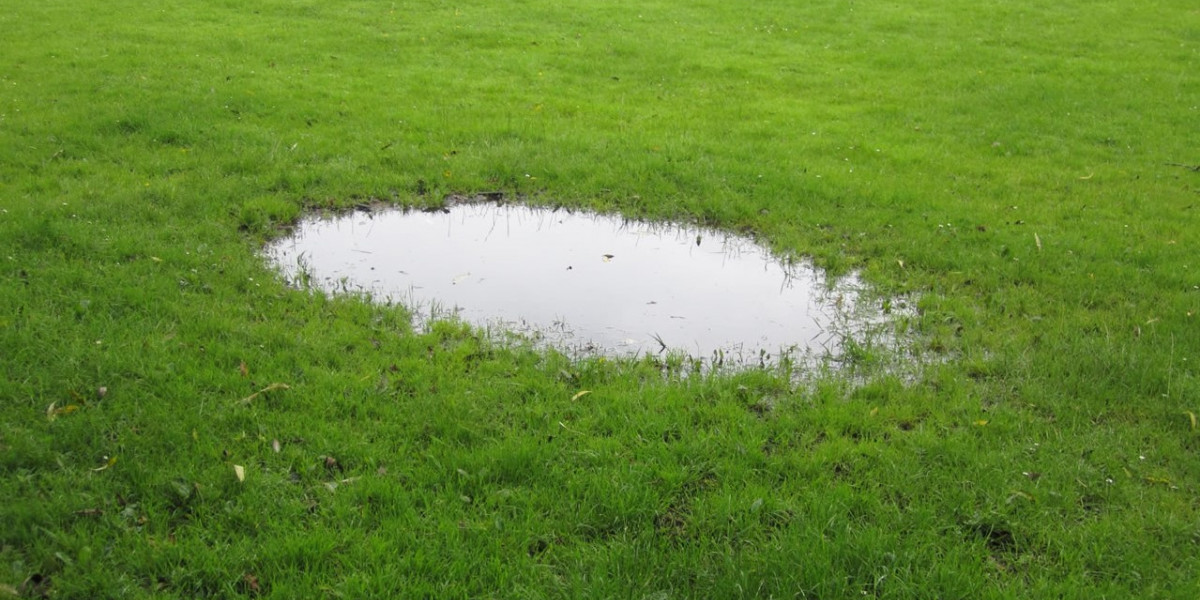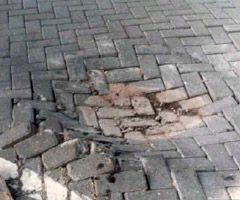What Are Sinkholes? Causes, Types and Solutions
A sinkhole is a depression or cavity caused by the collapse of the surface layer due to loss of support from below. While sinkholes are a natural phenomenon, they are often triggered or accelerated by human activities such as construction, land development, water management practices and mining activities.
In this guide, we’ll take a closer look at what sinkholes are, how they form, what causes them and the solutions for identifying and mitigating them.
- What is a sinkhole?
- How do sinkholes form?
- What causes sinkholes?
- What are the types of sinkholes?
- What are the warning signs of sinkhole formation?
- Identifying sinkholes before they collapse
- Solutions for repairing sinkholes
- How Tensar solutions can help
What is a sinkhole?
A sinkhole is a depression or hole in the ground that occurs when the surface layer collapses into an underground void or cavity. When the weight of the overlying material exceeds the strength of the remaining support, a collapse can occur, leading to a sinkhole.
Sinkholes can vary in size from a slight depression to a massive hole, tens of metres across. The deepest sinkhole is in Chongqing, China. Known as the ‘Heavenly Pit’, it is 537m wide, 662m deep and has a volume equal to 48,000 Olympic-sized swimming pools.

The "Heavenly Pit" in Chongqing, China is the deepest sinkhole in the world.
(Source: Wikipedia)
How do sinkholes form?
Most sinkholes form as a result of natural processes that remove rock below the surface layer. Where the bedrock is limestone, other carbonate, salt beds, or other soluble rock (such as gypsum), groundwater percolating through fissures can dissolve the rock and flush it away. Rainwater absorbs carbon dioxide, creating a weak carbonic acid that attacks the alkaline rock. Sandstone and quartzite rocks can also be removed by the dissolution of the carbonate cement holding the granular particles together, followed by erosion of the loose particles, forming a sinkhole.
Other causes of sinkholes can be man-made, such as a change in the water table due to mining, groundwater extraction, or erosion of subsurface material (due to a burst water main or leaking pipework, for example).
\
Andrew Lees visits a sinkhole at a major highway in South Africa and explains how they occur.
What is the cause of sinkholes?
Sinkholes are caused by the collapse of the surface layer due to loss of support from below. Cohesive or cemented granular surface layers can form a bridge over the void giving no indication that a void, has formed beneath, but a trigger event will eventually lead to collapse. This trigger can be a major rainfall event, a change in surface drainage and pore pressure, the emptying of a storage tank or even heavy irrigation. Such events saturate and weaken the surface layer, leading to collapse into the void.
In most cases, it can take many years for a void below the surface layer to form, but it can happen rapidly. Sinkholes are commonly caused by three different processes: dissolution, collapse and erosion.
Dissolution
Dissolution is where soluble rock, such as limestone and chalk, dissolves when it comes into contact with acidic rainfall or groundwater. Over time, this slowly dissolves the rock, creating voids and cavities underground.
Collapse
Collapse occurs when the material above an underground void becomes too heavy or loses support, leading to a sudden drop into the cavity below. This can happen after heavy rainfall, which saturates the soil, or due to the weight of structures or sediments. When the overlying material above the underground void can no longer bear its own weight, it collapses.
Dissolution and collapse
In some circumstances, dissolution and collapse can occur simultaneously. Initially, dissolution creates voids in the bedrock, which may remain stable for a time. However, as these voids expand, the supporting material above becomes increasingly unstable, posing a risk of collapsing when it can no longer bear the weight of the soil or structures above.
Erosion
Sinkholes can also be caused by erosion, which is different from dissolution. Heavy rainfall can wash away weak soil and sediment from the surface, destabilising the ground above a cavity. This erosion can weaken the ground and lead to the eventual collapse of the surface layer into the void.
Discover all about our Geogrids solution
Help your construction project mitigate the formation of sinkholes, cut costs and boost performance
Learn More
What are the types of sinkholes?
There are three main types of sinkholes: solution sinkholes, cover-collapse sinkholes and cover-subsidence sinkholes. We’ll take a closer look at each of these below.
Solution sinkholes
Solution sinkholes form when water dissolves soluble bedrock, such as limestone, through chemical weathering. As the erosion worsens, small cavities can develop, eventually leading to larger voids beneath the surface. As these voids grow larger, the overlying material becomes unsupported, leading to the formation of a sinkhole.
In the UK, solution sinkholes are common in regions with karst topography, which is a type of landscape which features soluble rocks, underground streams, springs and caves.
Cover-collapse sinkholes
Cover-collapse sinkholes occur when the weight of the soil or sediment covering an underground void exceeds its structural integrity. This can happen after heavy rainfall or due to changes in the landscape, such as construction activities. When the covering material becomes saturated with water, it loses its support, resulting in surface depressions rather than large, deep depressions, which can still pose a threat to structures above the ground surface.
Cover-subsidence sinkholes
Cover-subsidence sinkholes form when soil slowly settles into an underground void created by the dissolution of bedrock. Unlike the sudden collapse seen in cover-collapse sinkholes, this process can take years, leading to surface depressions rather than large, deep depressions which can still pose a threat to structures above the surface of the ground.
Do sinkholes happen in the UK?
Yes, sinkholes in the UK do happen. It is not a common issue, but it is not rare to spot. Some areas, like the parts of Wales, the Peak District, and regions with chalk formations, are known to be more prone to sinkholes.
What are the warning signs of sinkhole formation?
There may be visual warnings of formation, whether that be the slow development or imminent collapse of a sinkhole. Depressions forming in the ground or new surface water ponding are a clear indication of subsoil movement. Buried pipes may show signs of damage, utilities might be disrupted, and pylons, posts or trees may become tilted. Another way a sinkhole forms is from building or concrete floor slabs that may show signs of cracking, or windows and doors that stop closing. All of these may be telltale signs of a developing sinkhole.

Water ponding in a depression forming over old mineworking
(Source: Geoinvestigate, UK)

Block paving depression indicating presence of a small sinkhole
(Source: Geoinvestigate, UK)
Identifying sinkholes before they collapse
For any new development, a study of geological maps can identify areas susceptible to sinkhole formation, but not the location of a specific void. While deep boreholes may identify a void, they can also easily miss underlying issues. A thorough understanding of soil properties, such as bearing capacity and shear strength of soil, is essential when assessing areas prone to sinkholes.
Newer techniques have become available, such as ground penetrating radar, low frequency and passive electromagnetic field technologies, and vibro-acoustics. However, these all require specialist geotechnical engineering expertise in order to carry out and interpret the data. Displacement measurement using satellite remote sensing can also identify developing sinkholes, with the potential to provide early warning services for key infrastructure.
Solutions for repairing sinkholes
When sinkholes are detected or following a collapse, steps can be taken to prevent further collapse or enlargement. The steps will usually involve filling the void and surrounding fissures with grout or cementitious material, or if the void opening is not too large, capping over the void with a reinforced concrete slab. In the event of a sinkhole, Tensar solutions can be installed as a void-bridging solution. Geogrids are layered with engineered fill to span over collapsed areas, restoring surface integrity while reducing future risk.
Mitigating against sinkhole collapse
In areas designated for new construction that have been identified as having the potential for sinkholes, prevention by grouting or filling all voids before infrastructure development may be a solution. Where this is not practical, some form of mitigation against rapid collapse may be employed, where the objective is not to prevent collapse, but to avoid a rapid and potentially catastrophic collapse. Whatever solution is employed, the design will need to be carried out by specialist engineers following extensive ground investigations.
Tensar also supports other solutions to mitigating the possibility of sinkhole formation. With geotextiles and drainage layers, they can enhance water flow and mitigate hydrostatic pressure, two key contributors to sinkhole activity.
How Tensar solutions can help
Our Tensar InterAx™ and TriAx® Geogrids are used in subgrade stabilisation to distribute loads over a wider area, minimise differential settlement and reinforce soft soils. Our Tensar Plus program provides comprehensive geotechnical engineering support and design recommendations tailored to your project's specific needs. By using advanced geogrid technology, we can strengthen the soil and reduce the likelihood of surface collapse.
For further assistance with any questions or inquiries you may have, contact our team today.



.png?width=400&height=400&ext=.png)